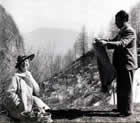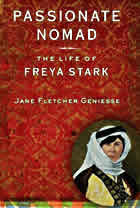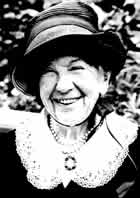Fembio Specials Famous Italian Women Freya Stark
Fembio Special: Famous Italian Women
Freya Stark

Born January 31, 1893 in Paris
died May 9, 1993 in Asolo, Italy
British traveller and explorer of the Middle East, travel author
Biography • Literature & Sources
Biography
Raised in Italy and England by liberal-minded parents, Freya Stark already spoke several languages as a child. Riding and mountaineering were part of her education, and with her mother and grandmother as role models she developed into an unconventional woman who was as at home in elegant salons as she was able to deal with poverty and physical exertion.
In spite of her delicate and sickly constitution, Freya Stark was tough and tenacious. In 1912 she began her studies in history at Bedford College in London, but broke them off with the onset of the First World War, when she left for Bologna to work as a nurse.
She had problems with self-esteem, feeling awkward and unattractive because she had to wear clothes tailored by her mother. Later in life, when she had her own money, she was known for her elegant and extravagant clothes/outfits.
Her engagement to a physician from Bologna was short-lived. Shocked, Freya moved to London, where for a time she worked as a censor of international correspondence – good preparation for her later collaboration with the Ministry of Information in London, where she would be employed as an expert on the Middle East during the Second World War.
 From 1917 until the end of the war she was active again as a nurse in Italy. After the war her father, a sculptor, gave her a small estate in Mortola on the Riviera, where she grew grapes, vegetables, and flowers. But she regularly traveled to London in order to take Arabic language courses at the School of Oriental Studies. In the meantime she was developing a desire to travel to the Middle East to learn the languages there. She applied – unsuccessfully – for a position as governess for the Iraqi princesses at the court of Baghdad.
From 1917 until the end of the war she was active again as a nurse in Italy. After the war her father, a sculptor, gave her a small estate in Mortola on the Riviera, where she grew grapes, vegetables, and flowers. But she regularly traveled to London in order to take Arabic language courses at the School of Oriental Studies. In the meantime she was developing a desire to travel to the Middle East to learn the languages there. She applied – unsuccessfully – for a position as governess for the Iraqi princesses at the court of Baghdad.
In 1927 she finally made it to Lebanon. She was now in her mid-thirties, single and seeing no meaningful prospects for herself at home. From Lebanon she traveled to Damascus, took more lessons in Arabic and mingled with the locals, to the consternation of colonial social circles. A first dangerous trip brought her to Druze territory, which was under martial law. She could have been murdered.
After travelling in the Middle East for seven months she returned to London to take drawing courses so that in the future she could make her own maps. In 1929 Freya Stark began her next trip to the Middle East. She traveled from Damascus to Baghdad, where she associated with English diplomats and officers as well as with locals; she went on desert excursions to the Bedouins, accompanied exclusively by Iraqi nationals, thus contravening the colonial moral code of the time.
 In 1930, Freya Stark – in the meantime she had also learned Persian – set out for Persia. The goal of her trip was to visit the Valleys of the Assassins, at the time still unexplored by Europeans, and carry out geographical and archeological studies. The Assassins were fanatical followers of a sect belonging to Shiite Islam, who used religious reasons to justify killing their enemies. They were said to enjoy hashish, which is reflected in the name “hashshashun,” or hashish-smoker. French crusaders derived the word “assassin” from the word “Hashshashun”, which came to mean “murderer” in Romance languages. The reign of the Assassins began in the 11th century and ended in the 13th century after the Mongol conquest.
In 1930, Freya Stark – in the meantime she had also learned Persian – set out for Persia. The goal of her trip was to visit the Valleys of the Assassins, at the time still unexplored by Europeans, and carry out geographical and archeological studies. The Assassins were fanatical followers of a sect belonging to Shiite Islam, who used religious reasons to justify killing their enemies. They were said to enjoy hashish, which is reflected in the name “hashshashun,” or hashish-smoker. French crusaders derived the word “assassin” from the word “Hashshashun”, which came to mean “murderer” in Romance languages. The reign of the Assassins began in the 11th century and ended in the 13th century after the Mongol conquest.
On the back of a mule, equipped with a camp bed and a mosquito net, and accompanied by a local guide, Freya Stark rode to the valleys near Alamut (= ruins of a mountain fortress castle near the Alamut River), which had not yet been recorded on her map. Malaria, a weak heart, dengue fever, and dysentery plagued her, but she continued her trip and her studies. Back in Baghdad, she received much recognition from the colonial circles; overnight she had gained a reputation as an explorer and scholar to be taken seriously.
Freya returned to England, took up contact with the Royal Geographical Society, deepened her geographical and cartographic knowledge and prepared for her next trips. She traveled to Kurdistan, Persia, Yemen, Egypt, Iraq and India, studied the land, the people, and their culture, and made maps. She had soon become a famous and widely recognized expert on these countries. She gave lectures at the Royal Central Asian Society and for the BBC.
Freya Stark spent the war years back in the Middle East, this time however as an advisor to the British colonial administration. Her knowledge of Arab customs and mentality was used to influence the local population in a pro-British direction, and she produced radio shows in Arabic in Aden to this end. She was fully convinced that British politics served the interests not only of Britain but also of the indigenous population. She compared the relationship between colonial administration and indigenous population to that between parent and child.
 Stark spent the last part of the war in India at the court of the British Viceroy. During political discussions there she became acquainted with Gandhi and Nehru. At parties, excursions, and dances she was a welcome guest. A popular dance partner, her extravagant clothes were also always a topic of conversation. After the war, Stark returned to Asolo, the place of her childhood. She was engaged by the British Ministry of Information as a political advisor to help improve relations with Italy. The marriage begun in September 1947 to the English diplomat Steward Perowne – she was 54, he 46 – lasted only four years. After the separation, Stark planned trips to Asia Minor, in preparation for which she took history lessons and – at almost 60 – learned Turkish. During this time she was awarded an honorary doctorate from the University of Glasgow. She wrote books on Turkey, Mesopotamia at the time of the Romans, and Alexander the Great.
Stark spent the last part of the war in India at the court of the British Viceroy. During political discussions there she became acquainted with Gandhi and Nehru. At parties, excursions, and dances she was a welcome guest. A popular dance partner, her extravagant clothes were also always a topic of conversation. After the war, Stark returned to Asolo, the place of her childhood. She was engaged by the British Ministry of Information as a political advisor to help improve relations with Italy. The marriage begun in September 1947 to the English diplomat Steward Perowne – she was 54, he 46 – lasted only four years. After the separation, Stark planned trips to Asia Minor, in preparation for which she took history lessons and – at almost 60 – learned Turkish. During this time she was awarded an honorary doctorate from the University of Glasgow. She wrote books on Turkey, Mesopotamia at the time of the Romans, and Alexander the Great.
In spite of physical problems and illnesses, she never stopped travelling. At 76 she was in Persia again, before that in Afghanistan and Iraq. At 86 she travelled to the Annapurna in the Himalayas. In 1972 she was knighted/raised to the rank of the nobility and could now call herself “Dame Freya Stark.”
Freya Stark worked through her many varied experiences in numerous, highly-praised travelogues and in political and philosophical works, some of which have also been translated into German. Her books are read all over the world.
She spent the last years of her long life (she lived to be over one hundred) in Asolo.
(Transl. Ute Methner and Joey Horsley)
Author: Sibylle Duda
Literature & Sources
Geniesse, Jane Fletcher. 2001. Passionate Nomad: The Life of Freya Stark. Modern Library.
Robinson, Jane. 1991. Wayward Women: A Guide to Women Travellers. Oxford; New York. Oxford University Press,
Stark, Freya. 1961. Dust in the Lion's Paw. Autobiography 1939-1946. London. John Murray.<
Stark, Freya. 1995. Freya Stark in Southern Arabia (Freya Stark Archives). Hg. Malise Ruthven. Garnet Publishing.
Stark, Freya. 1996. Baghdad Sketches. Einleitung Barbara Kreiger. Northwestern University Press.
Stark, Freya. 2001. The Southern Gates of Arabia: A Journey in the Hadhramaut. Modern Library.
If you hold the rights to one or more of the images on this page and object to its/their appearance here, please contact Fembio.







